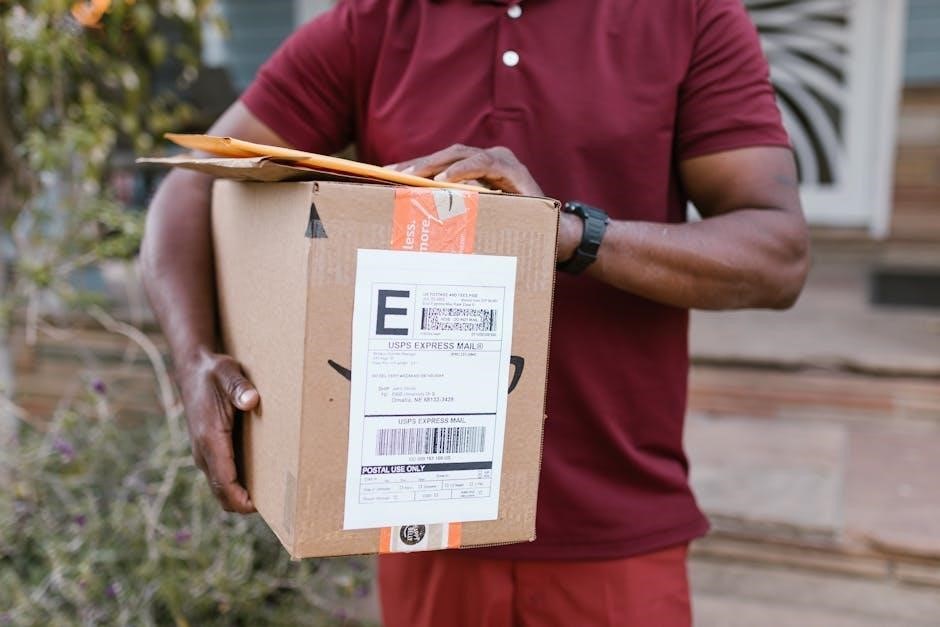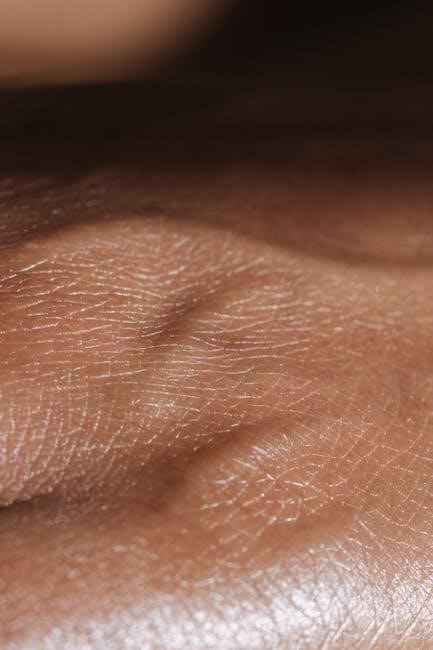A Micro PDF Barcode is a compact version of the PDF417 barcode, designed for encoding data in limited spaces․ It is widely used in healthcare, retail, and logistics due to its efficiency and high data capacity․ This 2D barcode standard supports error correction and is ideal for applications requiring precise data storage and retrieval․ Its smaller size makes it suitable for small labels while maintaining readability and reliability․
Overview of Micro PDF Barcode Technology
The Micro PDF Barcode is a compact version of the PDF417 barcode, designed for encoding data efficiently in limited spaces․ It is a 2D barcode technology that stores data in a series of rows and columns, enabling high-capacity data storage․ This barcode type is optimized for small dimensions while maintaining readability and reliability․ It is widely used in healthcare, retail, and logistics for labeling small items or documents․ The technology supports error correction, ensuring data integrity even when the barcode is damaged․ Micro PDF Barcodes are suitable for applications requiring precise data encoding and retrieval, making them a versatile solution for modern industries․ Their compact size and high functionality make them ideal for environments where space is a constraint but data accuracy is critical․ This technology ensures seamless integration with various systems, supporting multiple encoding standards for diverse use cases․
Importance of Micro PDF Barcodes in Modern Applications
Micro PDF Barcodes are crucial in modern applications due to their compact size and high data capacity, making them ideal for space-constrained environments․ Their ability to encode extensive information, including text, numbers, and even binary data, ensures versatility across industries․ The technology’s error correction capabilities enhance reliability, minimizing data loss and ensuring accurate scanning․ In healthcare, they are used for patient identification and medication tracking, while in retail, they facilitate inventory management and product authentication․ The pharmaceutical industry leverages them for drug traceability, ensuring compliance with regulations․ Their compatibility with various printing technologies and scanning devices makes them a preferred choice for diverse applications․ As industries seek efficient and reliable data encoding solutions, Micro PDF Barcodes play a pivotal role in streamlining operations and enhancing customer satisfaction․ Their importance continues to grow with advancing technological demands․

Types of Micro PDF Barcodes
Micro PDF Barcodes include Micro PDF417, Compact PDF417, and Macro PDF417․ These variations of the PDF417 standard are designed for different applications, offering flexibility in size and data capacity while maintaining high reliability and error correction capabilities․
Micro PDF417 Barcodes
Micro PDF417 barcodes are a compact version of the PDF417 standard, designed for applications with limited space․ They use Reed-Solomon error correction for high reliability and can store up to 1,․ These 2D barcodes are ideal for encoding detailed information like text, numbers, and binary data․ Their small size makes them suitable for use on small labels, tickets, and documents․ Micro PDF417 barcodes are widely used in healthcare, pharmaceuticals, and logistics due to their ability to store large amounts of data securely․ They support multiple encoding modes, including byte, text, and numeric, ensuring flexibility for various needs․ Their structure allows for efficient data retrieval, even when the barcode is partially damaged․ This makes them a reliable choice for industries requiring precise and secure data storage solutions․
Compact PDF417 Barcodes
Compact PDF417 barcodes are a space-efficient variant of the PDF417 standard, optimized for applications requiring minimal label space․ They use a reduced number of overhead symbols, enabling them to encode data more efficiently while maintaining readability․ Compact PDF417 barcodes are ideal for situations where both data capacity and label size are critical factors․ They support various encoding modes, including text, numeric, and binary, allowing flexibility in data storage․ These barcodes are widely used in industries like retail, healthcare, and manufacturing for product labeling, ID cards, and documentation․ Their compact design ensures high data density without compromising error correction capabilities, making them a reliable choice for applications with strict space constraints and high data requirements․
Macro PDF417 Barcodes
Macro PDF417 barcodes are designed for applications requiring high data capacity and robust error correction․ Unlike their compact counterparts, macro barcodes use multiple segments to store large amounts of information, making them ideal for scenarios where extensive data encoding is necessary․ They are commonly used in industries like logistics, healthcare, and government for labeling shipments, identification cards, and official documents․ Macro PDF417 barcodes support advanced error correction, ensuring data integrity even when the barcode is damaged․ Their ability to encode text, numbers, and binary data makes them versatile for various needs․ Additionally, they are compatible with standard PDF417 readers, ensuring widespread readability and integration into existing systems․ This makes macro PDF417 barcodes a reliable choice for applications requiring high reliability and large-scale data storage․

Generating Micro PDF Barcodes
Micro PDF barcodes can be generated using libraries like Aspose․BarCode for Python via ․NET․ Create a BarCodeGenerator, set the encode type to MicroPDF417, and save the barcode as an image or PDF for various applications․
Using Python Libraries for Barcode Generation
Python offers robust libraries for generating Micro PDF barcodes, such as segno, pdf417gen, and Aspose․BarCode for Python via ․NET․ These libraries provide tools to encode data into barcodes efficiently․ For instance, segno supports QR and MicroQR codes, while pdf417gen is specialized for PDF417 barcodes, including Micro PDF417․ Aspose․BarCode allows generating various barcode types, including Micro PDF417, with customizable settings like error correction levels and module sizes․ These libraries enable developers to create high-quality barcodes in formats such as SVG, PNG, or PDF, suitable for industrial and commercial applications․ By leveraging these tools, users can streamline barcode generation processes, ensuring accuracy and reliability in data representation․ These libraries are widely adopted due to their simplicity and integration with Python’s ecosystem, making barcode creation accessible even to novice developers․
Steps to Create Micro PDF417 Barcodes in Python
To create Micro PDF417 barcodes in Python, follow these steps:

- Install the Required Library: Use
pip install aspose․barcodeto install Aspose․BarCode for Python via ․NET, which supports Micro PDF417 generation․ - Import the Library: Include the necessary modules in your script to access barcode generation functions․
- Set Up the Encoder: Create a BarCodeGenerator object and specify Micro PDF417 as the encode type․
- Configure Settings: Customize error correction levels and module sizes to optimize the barcode for your needs․
- Generate the Barcode: Use the save method to generate the barcode and save it as an image or PDF․
- Optional Customization: Adjust colors, margins, and other visual properties for specific requirements․
This process ensures high-quality Micro PDF417 barcodes suitable for various applications, leveraging Python’s simplicity and the library’s robust features․

Tools and Libraries for Micro PDF Barcode Creation
Popular tools include Aspose․BarCode for Python via ․NET, segno, and pdf417gen․ These libraries offer robust features for generating Micro PDF417 barcodes with high customization and efficiency․
Popular Python Libraries for Barcode Generation
Several Python libraries are widely used for generating barcodes, including Micro PDF barcodes․ Aspose․BarCode for Python via ․NET is a powerful library that supports various barcode types, including PDF417, QR Code, and Micro QR Code․ It offers advanced customization options such as adjusting barcode dimensions, colors, and error correction levels․ Another popular choice is segno, which specializes in generating QR codes and Micro QR codes․ It is lightweight and supports multiple output formats like SVG, PNG, and PDF․ Additionally, pdf417gen is a dedicated library for creating PDF417 barcodes, including Micro PDF417, with features like data encoding and error correction․ These libraries provide developers with flexible tools to integrate barcode generation into their applications efficiently;
Aspose․BarCode for Python via ․NET
Aspose․BarCode for Python via ․NET is a robust library designed to generate and scan various barcode types, including Micro PDF417 barcodes․ It supports multiple file formats such as JPEG, SVG, PNG, and PDF, making it versatile for different applications․ The library allows developers to customize barcode properties like dimensions, colors, and error correction levels․ With its advanced features, it is particularly suitable for enterprise-level applications requiring high-quality barcode generation․ Aspose․BarCode also enables seamless integration with ․NET frameworks, providing a reliable solution for encoding data into Micro PDF417 barcodes․ Its flexibility and comprehensive functionality make it a popular choice among developers for creating precise and readable barcodes tailored to specific needs․

Applications of Micro PDF Barcodes

Micro PDF barcodes are widely used in healthcare, retail, and logistics for labeling products, tracking inventory, and storing patient or customer data efficiently․ Their compact size and high data capacity make them ideal for applications requiring precise data storage and retrieval․
Industry Use Cases for Micro PDF Barcodes
Micro PDF barcodes are widely utilized across various industries due to their compact size and high data capacity․ In healthcare, they are used for patient identification, medication tracking, and medical record labeling․ Retail industries leverage them for inventory management, product labeling, and supply chain tracking․ Logistics and shipping companies employ Micro PDF barcodes for package tracking and delivery confirmation․ Pharmaceutical companies use them for drug traceability and anti-counterfeiting measures․ Automotive manufacturers utilize these barcodes for parts identification and warranty tracking․ Their versatility and reliability make them a preferred choice for industries requiring efficient data management and accurate tracking systems․ The ability to store large amounts of data in a small space, combined with robust error correction, ensures their widespread adoption across diverse sectors․


